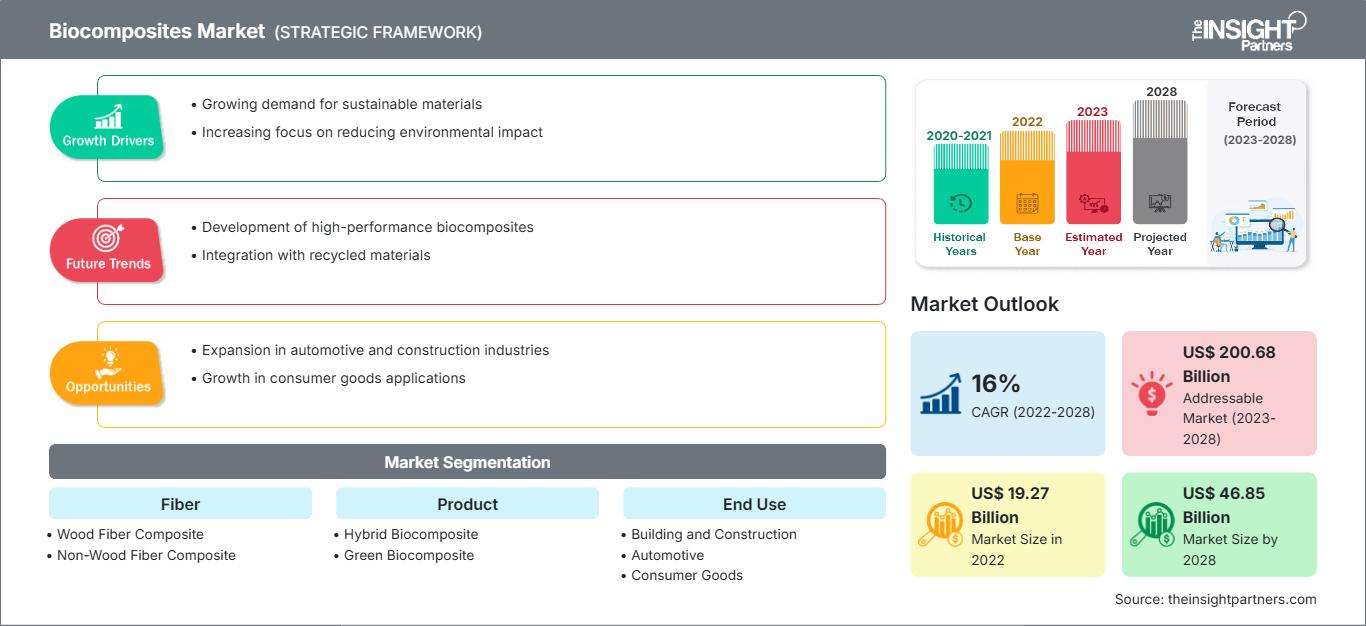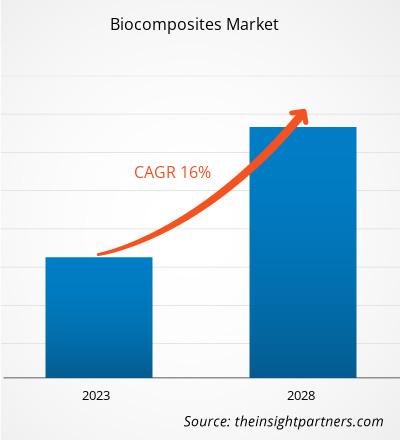[연구 보고서] 바이오 복합재 시장은 2022년 192억 6,862만 달러에서 2028년 468억 5,139만 달러로 성장할 것으로 예상되며, 2022년부터 2028년까지 연평균 16% 성장할 것으로 예상됩니다.
시장 분석
바이오 복합재는 천연 섬유와 매트릭스(수지)를 강화하여 만든 소재입니다. 바이오 복합재는 기초 연구, 포장, 건설, 군사, 항공우주, 철도 차량, 자동차 등 다양한 산업 분야에서 활용되고 있으며, 접근성, 높은 비강도, 경량성, 생분해성, 재활용성, 저렴한 비용, 재생 가능성 등 다양한 잠재적 이점을 제공합니다. 바이오 복합재는 자동차 산업에서 내장 패널 제조에 널리 사용되고 있습니다. 바이오 복합재는 친환경적이기 때문에 다양한 분야에서 고가의 폴리머 복합재를 대체하고 있습니다.
성장 동력 및 과제
지속 가능한 건축 자재 사용 증가는 바이오 복합재 시장 성장에 기여했습니다. 건설 산업은 도시 인구 증가로 인해 급속한 도시화 속에서 가장 빠르게 성장하는 신흥 분야 중 하나입니다. 이러한 도시화로 인해 건설 산업은 재생 불가능한 자원에서 생산되는 자재를 가장 많이 소비하는 분야가 되었습니다. 세계건축건설연합(Global Alliance for Building and Construction)의 보고서에 따르면, 건설 부문은 환경에 가장 큰 피해를 주는 분야 중 하나입니다. 이 연구에 따르면, 건설 부문은 환경에 분산되는 이산화탄소 배출량의 39%, 전 세계 에너지 소비량의 36%, 그리고 원자재 채굴량의 50%를 차지합니다. 이러한 배출량은 주로 기후 변화의 원인이 되고 지구 온도를 상승시킵니다. 기존 건축 자재는 자원과 에너지를 매우 많이 소모합니다. 따라서 사회적, 환경적 영향을 미치는 기존 건축 자재의 유해성에 대한 우려와 인식이 높아지고 있습니다. 이러한 문제를 해결하기 위해 건설 업계에서는 새로운 자재와 기술이 개발되고 있습니다. 바이오 복합재는 지속 가능한 건축 자재로, 재생 불가능한 폐기물을 제거하고 원자재 사용량을 줄이며 화석 연료 소비를 줄이는 데 도움이 됩니다. 바이오 복합재는 재생 가능하고 재활용 가능하며 생분해성 소재로 만들어지고 구조적 및 비구조적 건축 요소로 광범위하게 사용되기 때문에 건설 업계에서 바이오 복합재 사용에 대한 관심이 전 세계적으로 증가하고 있습니다. 그러나 천연 섬유 복합재는 섬유-매트릭스 계면 결합력 저하, 습윤성 저하, 수분 흡수율 저하 등 몇 가지 단점이 있습니다. 이러한 단점은 최종 제품의 강도와 성능에 영향을 미칩니다. 바이오 복합재의 친수성은 주변 환경의 물을 흡수하는 경향이 있어 복합재가 팽창합니다. 이러한 모든 요인들이 예측 기간 동안 바이오 복합재 시장 성장을 저해할 것으로 예상됩니다.
요구 사항에 맞게 이 보고서를 사용자 정의하십시오.
이 보고서의 일부, 국가 수준 분석, Excel 데이터 팩을 포함하여 모든 보고서에 대한 사용자 정의를 무료로 받을 수 있을 뿐만 아니라 스타트업 및 대학을 위한 훌륭한 제안 및 할인을 이용할 수 있습니다
생체 복합재 시장: 전략적 통찰력

-
이 보고서의 주요 주요 시장 동향을 확인하세요.이 무료 샘플에는 시장 동향부터 추정 및 예측에 이르기까지 데이터 분석이 포함됩니다.
보고서 세분화 및 범위
"2028년까지의 글로벌 바이오 복합소재 시장 분석"은 글로벌 바이오 복합소재 시장 동향과 성장 기회에 중점을 둔 전문적이고 심층적인 연구입니다. 본 보고서는 섬유, 제품, 최종 용도 및 지역별 세부적인 시장 세분화를 통해 글로벌 바이오 복합소재 시장에 대한 개요를 제공합니다. 글로벌 바이오 복합소재 시장은 최근 높은 성장을 기록해 왔으며, 예측 기간 동안 이러한 추세가 지속될 것으로 예상됩니다. 본 보고서는 주요 지역 및 국가의 수요와 함께 전 세계 바이오 복합소재 소비량에 대한 주요 통계를 제공합니다. 또한, 주요 지역 및 국가의 바이오 복합소재 시장 성과에 영향을 미치는 다양한 요인에 대한 정성적 평가를 제공합니다. 또한, 바이오 복합소재 시장의 주요 기업과 이들의 주요 전략 개발에 대한 포괄적인 분석을 포함합니다. 시장 역학에 대한 여러 분석도 포함되어 주요 추진 요인, 시장 동향, 그리고 수익성 있는 바이오 복합재 시장 기회를 파악하는 데 도움을 줍니다. 이는 궁극적으로 주요 수익원을 파악하는 데 도움이 될 것입니다.
또한, 생태계 분석과 포터의 5가지 힘 분석은 글로벌 바이오 복합재 시장에 대한 360도 관점을 제공하여 전체 공급망과 시장 성장에 영향을 미치는 다양한 요인을 이해하는 데 도움이 됩니다.
세분화 분석
글로벌 바이오 복합재 시장은 섬유, 제품, 최종 용도를 기준으로 세분화됩니다. 섬유 기준으로 바이오 복합재 시장은 목재 섬유 복합재와 비목재 섬유 복합재로 나뉩니다. 제품 기준으로 시장은 하이브리드 바이오 복합재와 친환경 바이오 복합재로 분류됩니다. 최종 용도 기준으로 시장은 건축 및 건설, 자동차, 소비재 등으로 구분됩니다.
섬유 기준으로는 목재 섬유 복합재 부문이 바이오 복합재 시장 점유율에서 상당한 비중을 차지했습니다. 목재 섬유 복합재의 주요 단점은 습기에 대한 민감성입니다. 그러나 연구 개발이 증가함에 따라 제조업체들은 더 높은 습기 저항성, 더 높은 강성, 그리고 더 낮은 열팽창 계수를 가진 목재 섬유 부품을 생산하고 있습니다. 하이브리드 복합재 제품을 기준으로 볼 때, 바이오 복합재 시장은 가장 큰 시장 점유율을 기록하며 시장을 주도하고 있습니다. 최종 용도 기준으로는 건축 및 건설 부문이 바이오 복합재 시장을 주도하고 있습니다. 건축용 바이오 복합재는 골조, 벽체 및 벽판, 창틀, 문, 바닥재, 장식 패널, 칸막이 벽, 천장 패널 등에 사용됩니다. 임시 및 조정 가능한 건축 자재에 바이오 복합재를 사용하면 구조물 내부 디자인을 변경할 때 발생하는 매립 폐기물을 줄일 수 있습니다.
지역 분석
이 보고서는 북미, 유럽, 아시아 태평양(APAC), 중동 및 아프리카(MEA), 중남미의 5개 주요 지역을 기준으로 전 세계 바이오 복합재 시장에 대한 자세한 개요를 제공합니다. 아시아 태평양 지역은 시장에서 상당한 점유율을 차지했으며 2022년에는 미화 93억 달러 이상의 시장 가치를 달성할 것으로 예상됩니다. 아시아 태평양 지역은 중국, 인도, 일본, 한국, 호주 등 여러 개발도상국과 선진국으로 구성되어 있습니다. 아시아 태평양 지역의 성장에 기여하는 중요한 요인은 건축 및 건설, 운송 부문의 최종 사용 산업에 대한 수요 증가입니다. 바이오 복합재에 대한 높은 수요는 주로 중국, 일본, 인도, 한국에서 관찰됩니다. 또한 운송 및 인프라 부문에 대한 외국인 직접 투자(FDI) 증가는 향후 몇 년 동안 바이오 복합재 수요를 견인할 것으로 예상됩니다. 유럽 또한 정부의 인프라 건설 지출 증가로 인해 2028년에 약 미화 110억 달러에 달하는 상당한 성장을 보일 것으로 예상됩니다. 또한 북미 지역에서는 주거 및 상업 건축, 소비재, 자동차 부문에서 바이오 복합재가 널리 사용되고 있습니다. 이는 바이오 복합재 시장에 수익성 있는 기회를 창출했습니다. 북미의 바이오 복합재 시장은 예측 기간 동안 15.0%의 CAGR로 성장할 것으로 예상됩니다.
산업 개발 및 미래 기회
파트너십, 인수 및 신제품 출시는 글로벌 바이오 복합재 시장에서 활동하는 업체들이 채택한 주요 전략인 것으로 나타났습니다.
- 2022년 5월, Arkema는 재활용 가능하고 효율성이 더욱 향상된 복합재를 위한 새로운 솔루션을 출시할 계획입니다.
- 2021년 3월, Fiberon은 고성능, 저유지 관리 소재의 내구성과 결합된 목재의 탁월한 아름다움과 따뜻함을 제공하는 야생목 복합재 클래딩 출시를 발표했습니다.
생체 복합재 시장 지역별 통찰력
The Insight Partners의 분석가들은 예측 기간 동안 바이오 복합재 시장에 영향을 미치는 지역별 동향과 요인들을 면밀히 분석했습니다. 이 섹션에서는 북미, 유럽, 아시아 태평양, 중동 및 아프리카, 그리고 중남미 지역의 바이오 복합재 시장 부문 및 지역별 현황도 다룹니다.
생체 복합재 시장 보고서 범위
| 보고서 속성 | 세부 |
|---|---|
| 시장 규모 2022 | US$ 19.27 Billion |
| 시장규모별 2028 | US$ 46.85 Billion |
| 글로벌 CAGR (2022 - 2028) | 16% |
| 이전 데이터 | 2020-2021 |
| 예측 기간 | 2023-2028 |
| 다루는 세그먼트 |
By 섬유
|
| 포함된 지역 및 국가 |
북미
|
| 시장 선도 기업 및 주요 회사 프로필 |
|
생체 복합재 시장 참여자 밀도: 비즈니스 역학에 미치는 영향 이해
생체 복합재 시장은 소비자 선호도 변화, 기술 발전, 그리고 제품의 이점에 대한 인식 제고 등의 요인으로 인한 최종 사용자 수요 증가에 힘입어 빠르게 성장하고 있습니다. 수요 증가에 따라 기업들은 제품 라인업을 확장하고, 소비자 니즈를 충족하기 위한 혁신을 추진하며, 새로운 트렌드를 적극 활용하고 있으며, 이는 시장 성장을 더욱 가속화하고 있습니다.

- 을 얻으세요 생체 복합재 시장 주요 주요 플레이어 개요
COVID-19 팬데믹으로 인한 봉쇄, 여행 제한, 그리고 사업 중단은 북미, 유럽, 아시아 태평양(APAC), 중남미, 그리고 중동 및 아프리카(MEA) 여러 국가의 경제와 산업에 악영향을 미쳤습니다. 이 위기는 글로벌 공급망, 제조 활동, 배송 일정, 그리고 필수 및 비필수 제품 판매에 차질을 빚었습니다. 여러 기업들이 2020년 제품 배송 지연 및 향후 제품 판매 부진 가능성을 발표했습니다. 또한, 유럽, 아시아 태평양, 그리고 북미 여러 국가의 정부가 국제 여행 금지 조치를 시행하면서 여러 기업이 협력 및 파트너십 계획을 중단해야 했습니다. 이러한 모든 요인들이 화학 물질 및 2020년과 2021년 초에 재료 산업이 침체되어 바이오 복합재 시장을 포함한 이 산업과 관련된 다양한 시장의 성장이 억제되었습니다.
COVID-19 발생 이전에는 바이오 복합재 시장이 주로 자동차 및 건축 및 건설 산업의 수요 증가에 의해 주도되었습니다. 그러나 2020년에는 국가 및 국제 경계 폐쇄로 인한 가치 사슬의 중단으로 인해 다양한 산업이 운영 속도를 늦춰야 했습니다. COVID-19 팬데믹은 여러 국가의 정부 당국이 부과한 제한으로 인해 주요 원자재 공급망을 교란하고 제조 공정에 지장을 주었습니다. 그러나 경제는 운영을 재개했습니다. 이전에 연기되었던 건설 프로젝트가 재개되어 바이오 복합재 시장 참여자가 정상을 되찾을 수 있는 기회가 더욱 제공되었습니다.
경쟁 환경 및 주요 회사
바이오 복합재 시장에서 활동하는 주요 업체로는 TTS, Lingrove, Bcomp Ltd, UPM, Flexform Technologies 등이 있습니다. Tecnaro GmbH; Fiberon; Arkema; Trex Company, Inc.; HempFlax Group BV 등이 있습니다.
- 과거 분석(2년), 기준 연도, CAGR을 포함한 예측(7년)
- PEST 및 SWOT 분석
- 시장 규모 가치/거래량 - 글로벌, 지역, 국가
- 산업 및 경쟁 환경
- Excel 데이터세트
최근 보고서
관련 보고서
사용 후기
구매 이유
- 정보에 기반한 의사 결정
- 시장 역학 이해
- 경쟁 분석
- 고객 인사이트
- 시장 예측
- 위험 완화
- 전략 기획
- 투자 타당성 분석
- 신흥 시장 파악
- 마케팅 전략 강화
- 운영 효율성 향상
- 규제 동향에 발맞춰 대응






















 무료 샘플 받기 - 생체 복합재 시장
무료 샘플 받기 - 생체 복합재 시장